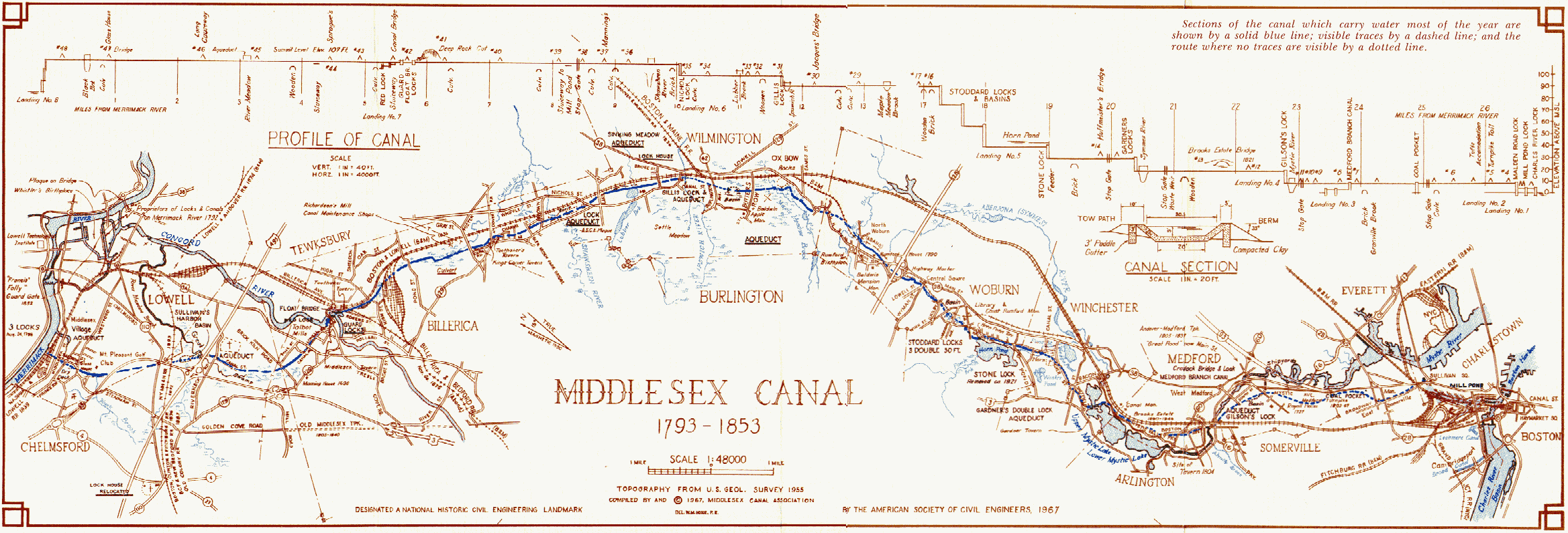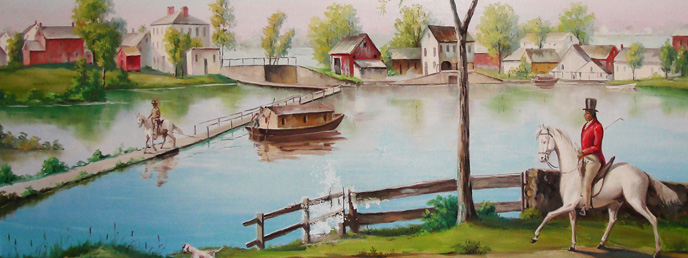


Middlesex Canal Association P.O. Box 333 Billerica, Massachusetts 01821
www.middlesexcanal.org
| Volume 59 No. 3 | May 2021 |
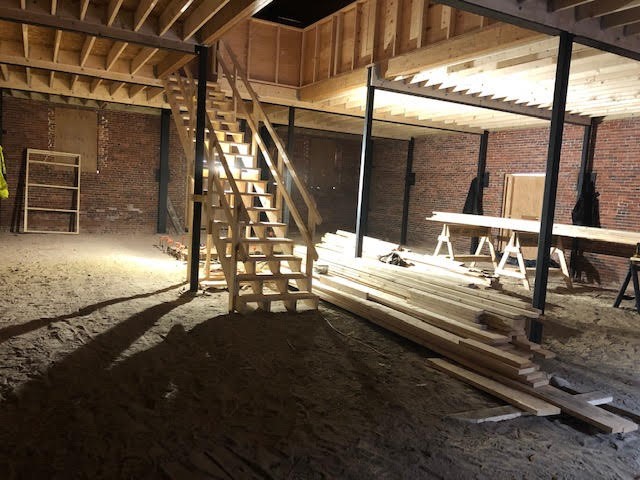
The first floor of the future site of the MCA Museum and Visitor Center.
The interior framing and temporary stairway are pictured here on February 17, 2021.
After a month and a half break work will at the site will continue in April.
Please mark your calendars!
MCA Sponsored Events – 2021 Schedule
Spring Meeting: 1:00pm, Sunday, May 16, 2021
“Lowell’s Part of the 27¼ Miles of the Middlesex Canal”
Presenter: J. Jeremiah Breen, MCA President
Thoreau Towpath Walk: 10:00am, Saturday June 19, 2021
Leader: Marlies Henderson, CIG
Registration Required
Eventbrite Signup: https://www.eventbrite.com/e/145377338533
Special Event: World Canal Conference
August 30 – September 3, 2021
Hosted by the Chesapeake and Ohio Canal Association
Hagerstown, Maryland
19th Annual Bicycle Tour, North: 9:00am, Saturday, October 2, 2021
Fall Walk: 1:30pm, Saturday, October 17, 2021
Medford Segment Walk
The Visitors Center/ Museum is open Saturday and Sunday, Noon – 4:00pm, except on a holiday.
The Board of Directors meets the 1st Wednesday of each month, 3:30-5:30pm, except July and August.
Check the MCA website for updated information during the COVID-19 pandemic.
TABLE OF CONTENTS
MCA Sponsored Events and Directions to the MCA Museum and Visitors’ Center
President’s Message by J. Jeremiah Breen
Progress on 2 Old Elm Street by Betty Bigwood
Charles Anderson Retires by Debra Fox
MCA Spring Walk: A Report by Jim Winkler
Sheldon Brought Oxen as a Revenge on Elegant Hotel by Larz Neilson
Loammi Baldwin in the New York Times by Howard Winkler
Nominees for MCA Officers & Directors, 2021-2022
Editors’ Letter
February, 2021
Winter wasn’t “that bad” this year but it is still wonderful to see trees and flowers come alive after the brown drab of the last few months. There is also some optimism that the COVID virus can be held at bay and life can return back to normal once everyone has a vaccine.
Check out the cover photo of this issue. It is the inside of the new museum in February. Work continues and progress is being made!
Coming events have a “first -up” priority in this issue. Bill Holdsworth has written an overview of the upcoming Baltimore & Ohio Canal Convention. It is followed by future MCA events: The Bicycle Tour, Fall Walk, and the ZOOM Annual Meeting. Also, Jim Winkler has sent in a recap of the Spring Walk that shouldn’t be missed.
Our first article is by Larz Neilson and is a humorous story about a Boston Contractor and his adventure at a Boston hotel and is reprinted from the Wilmington Town Crier. The next group of submissions is from Howard Winkler after his perusal of the New York Times in a hunt for articles about Loammi Baldwin.
Lastly, the MCC: Billerica Section says goodbye to Chuck Anderson on his retirement, and as per usual, the President’s Message, directions to the museum, and the miscellany.
As a reminder, May is member renewal month, so please get those checks to Neil Devins so the MCA can continue its work on the new museum!
Thanks for reading,
Deb Fox, Alec Ingraham, Robert Winters
MCA Sponsored Events and Directions to Museum
The constantly changing restriction and requirements engendered by the pandemic might force changes in event venues or even cancellations. Anyone planning to attend or participate in the activities listed on the calendar of events should consult the MCA website at www.middlesexcanal.org for up-to-date information.
Annual Meeting: The Annual Meeting of the MCA will be held virtually at 1:00pm on Sunday, May 16, 2021 in the venerable Howard Winkler’s ZOOM meeting room. The link will be posted on the MCA website, www.middlesexcanal.org. J. Jeremiah Breen, President of the MCA, will present a talk/video on the Middlesex Canal between I-495 and the Merrimack River, Lowell’s part of the 27¼ mile canal.
Thoreau Towpath Walk: As part of the SuAsCo Riverfest, the June 19th walk will begin at 10:00am at the gazebo by the Billerica Falls. The easy walk, over relatively flat terrain, will conclude at the Middlesex Canal Commission plaque at 121 Riverneck Road in Chelmsford. Knee high boots are recommended if the beaver dams have flooded the towpath or turn around. The round trip takes approximately three hours. National Association for Interpreters Certified Interpretative Guide Marlies Henderson will lead the walk, adhering to Governor Baker’s COVID-19 Orders. Registration is required for this event. Please sign up at https://eventbrite.com/e/145377338533.
Special Event Invitation
from Bill Holdsworth
The Chesapeake and Ohio Canal Association is getting ready to welcome enthusiasts from around the world to next year’s World Canal Conference, August 30 – September, 2021 in Hagerstown, MD. The COVID-19 pandemic has cast a cloud over the preparations. Leipzig, Germany was scheduled to host the 2020 conference in September, but the impact of the pandemic forced them to reschedule for May, 2022.
We will monitor developments over the coming months. We are hopeful that conditions will improve and that canal lovers will be ready to gather again. We will be celebrating the 50th anniversary of the creation of the C&O Canal National Historic Park. Construction of the C&O Canal began in 1828 in Washington, D.C. The canal reached Cumberland in 1850. It operated until 1924. The federal government acquired the disused waterway in 1938. Legislation transformed it into a national park in 1971.
The Conference theme will be: Historic Canals Today Education, Recreation, and Tourism
Many 19th-century waterways have found a new role in the 21st Century. The conference will provide an opportunity to hear the secrets of their successes. Mornings of the four-day event will feature presentations related to the conference theme. In the afternoon, attendees will hit the road for study tours that visit canal locations and other local history sites, such as Great Falls, Paw Paw Tunnel, and Antietam battlefield. Hagerstown is just eight miles from the C&O Canal, making the city an ideal base for canal enthusiasts to explore the area. Conveniently located near the junction of two interstate highways, I-81 and I-70, Hagerstown is a 7½ hour drive from North Billerica. You can learn more by visiting the conference website, https://wcc2021.org/ or the Visit Hagerstown website: http://www.visithagerstown.com
Save the date. We would love to welcome you in 2021.
From: Bill Holdsworth
C&O Canal Association
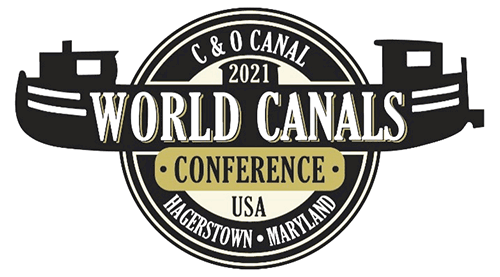
19th Annual Bicycle Tour, North: Last fall eighteen cyclists met at 9:00am at the Sullivan Square T Station. The route was altered as the trains for the return trip were not running on weekends. This year the 19th Annual Bicycle Tour, North is scheduled for October 2nd. Those interested in attending this year’s tour should, prior to the event, access the MCA website, www.middlesexcanal.org, for the latest information.
Fall Walk: On Sunday, October 17th, the MCA will sponsor a canal walk. The walk will begin at 1:30pm at the Sandy Beach parking lot, 4 Mystic River Parkway, Winchester, MA 01890. The walk is four miles round trip on pavement. Leader: Robert Winters
Fall Meeting: TBA When available, information of the MCA Fall Meeting will be posted on the MCA website, www.middlesexcanal.org.
Directions to Museum: 71 Faulkner Street in North Billerica, MA
By Car
From Rte. 128/95
Take Route 3 toward Nashua, to Exit 28 “Treble Cove Road, North Billerica, Carlisle”. At the end of the ramp, turn left onto Treble Cove Road toward North Billerica. At about ¾ mile, bear left at the fork. After another ¼ mile, at the traffic light, cross straight over Route 3A (Boston Road). Go about ¼ mile to a 3-way fork; take the middle road (Talbot Avenue) which will put St. Andrew’s Church on your left. Go ¼ mile to a stop sign and bear right onto Old Elm Street. Go about ¼ mile to the bridge over the Concord River, where Old Elm Street becomes Faulkner Street; the Museum is on your left and you can park across the street on your right, just beyond bridge. Watch out crossing the street!
From I-495
Take Exit 37, North Billerica, then south roughly 2 plus miles to the stop sign at Mt. Pleasant Street, turn right, then bear right at the Y, go 700’ and turn left into the parking lot. The Museum is across the street (Faulkner Street).
By Train
The Lowell Commuter line runs between Lowell and Boston’s North Station. From the station side of the tracks at North Billerica, the Museum is a 3-minute walk down Station Street and Faulkner Street on the right side.
President’s Message
by J. Breen
The bicentennial of Lowell’s founding is approaching. While the usual date is when the legislature grants a charter, March 1, 1826 for the new town of Lowell, a perhaps more appropriate date for what became a great manufacturing center, the 18th largest city in the United States, is the day when five men organized themselves as the Merrimack Manufacturing Company, December 1, 1821. The five chose to manufacture cloth at what became Lowell because of the power from the Pawtucket Falls and the low cost of transportation by the Middlesex Canal. In 1835, Lowell consumed 670 bales of cotton each week to produce 753,000 yards of cloth.1 Without water transportation, Lowell could not compete against mills which had water transportation.
A horse and wagon could haul 2 tons over rutted, hilly dirt roads. A horse and boat could glide through the smooth water of the 27-mile long canal, be lifted by locks, twenty on the Middlesex, hauling twenty tons. The first locomotive on the Boston & Lowell RR when it opened in 1835 was rated at 30 horsepower, and the trip between Lowell and Boston was an hour compared to eight hours on a canal boat. The Middlesex Canal Company was liquidated as it couldn’t compete against a steam engine on rails. The message for Vol. 59, No. 3, describes the present day route of the canal in Lowell 200 years after Lowell’s founding.
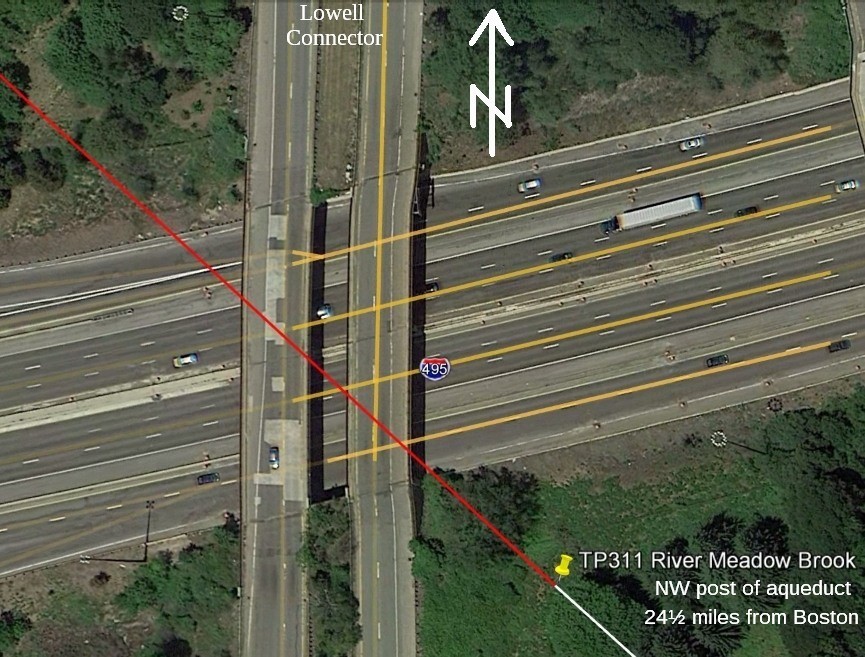
The canal entered Lowell from Boston where I-495 crosses the Lowell Connector. The location of the canal is plotted from an 1829 survey on the Google earth video, Thoreau Towpath, available at the Internet Archive.2 The I-495/Lowell Connector interchange is at video 3:03. The interchange has buried the River Meadow Brook aqueduct, one of two aqueducts in Lowell. The canal went north, the route passing just west of the movie theater, the road to the Meadowbrook electric substation is on top of the towpath, and the plotted 1829 towpath crossing the Freeman Rail Trail at the east entrance to the Route 3 tunnel. The towpath was approximately level with the trail. North of the Market Basket at 288 Chelmsford St. (Rte. 110), the canal is visible just west of Rte. 3. It flows under Rte. 3 through a culvert, heading north through the reed bed west of the Daley Middle and Bailey Elementary Schools.
The Middlesex Canal exists as noted above but in Mount Pleasant Golf Club it has a highly visible existence as the brook between the 2nd and 3rd fairways.
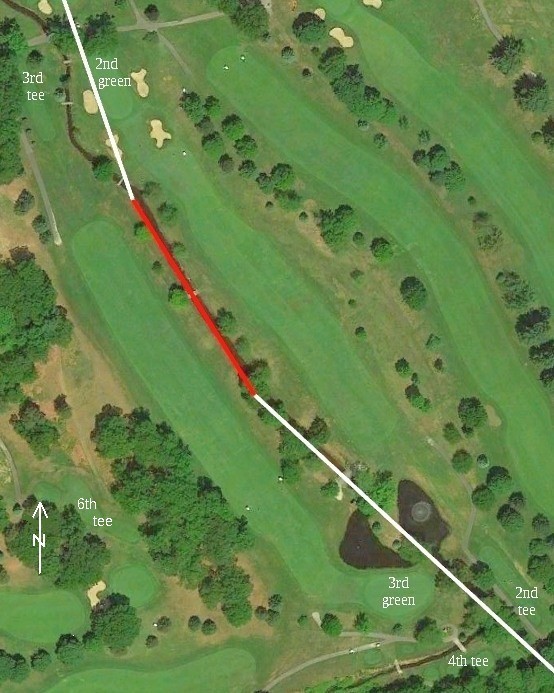
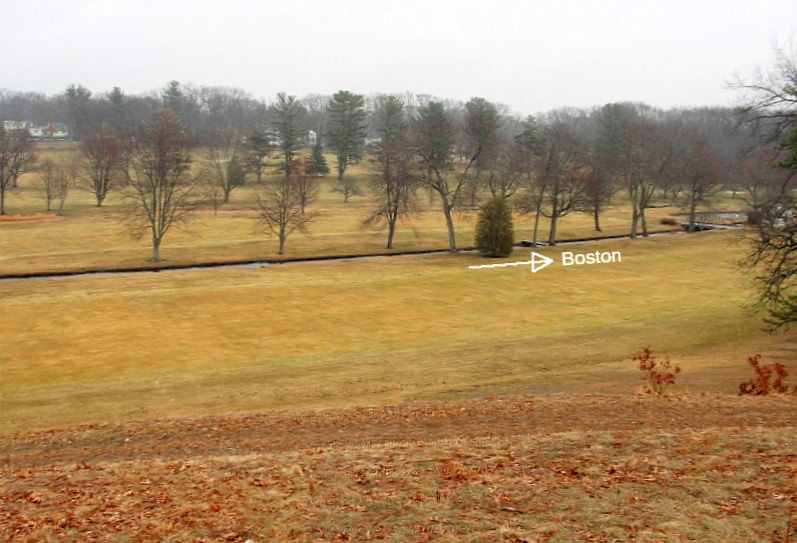
A plaque is on a granite pillar in Hadley Field with a map of the route to the river where the canal connection to the Merrimack has been replaced by a RR culvert at milepost 27.37 with an outlet 42” x 48” high.2
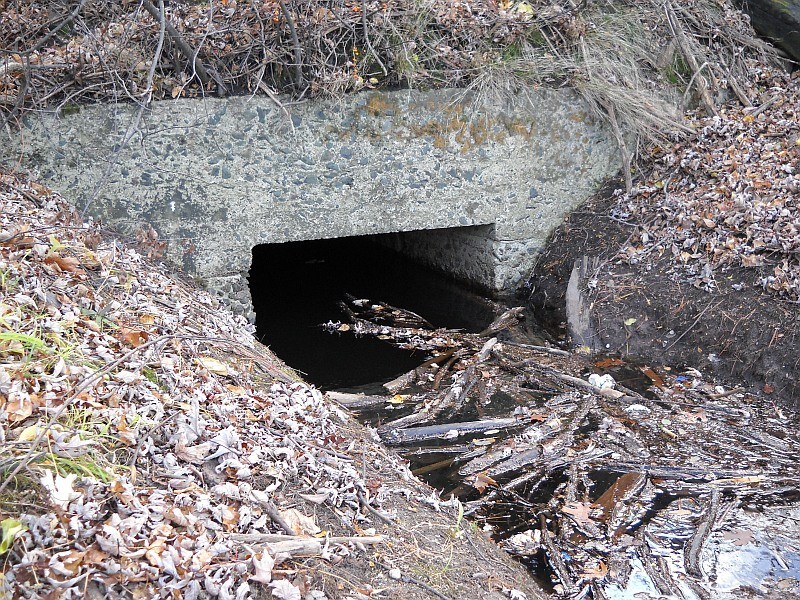
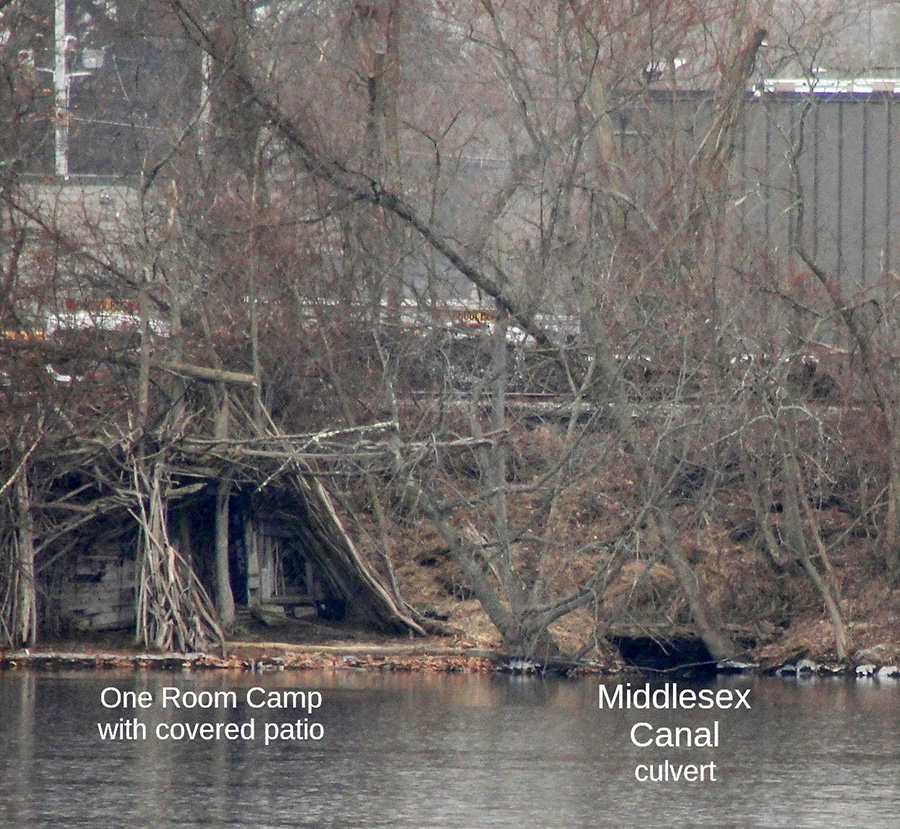
The photo of the One Room Camp and Middlesex Canal outlet is a taken from the north bank of the Merrimack. The Scott Finneral memorial on the Vandenberg Esplanade is directly opposite the canal outlet. The memorial is 200’ downriver of the UMass Bellegarde Boathouse, 500 Pawtucket Blvd, Lowell MA 01854.
Very truly yours,
J. Breen
jbreen5@verizon.net, 978-688-4322
Notes
1. Cotton Was King, Arthur Louis Eno, Jr., editor, Lowell Historical Society, 1976, p. 256, Appendix B, Statistics of Lowell Manufactures, 1835.
2. Video, Thoreau Towpath, https://archive.org/details/160117thoreautowpath.
3. See Towpath Topics, Vol. 54, No. 1 (Sep 2015), “Locks in Lowell” by J. Breen, http://middlesexcanal.org/towpath/towpathtopicsSept2015.htm#locks
Progress at 2 Old Elm
by Betty M. Bigwood
On December 23, 2020, after the shingles were installed on the new roof – our primary goal of the year 2020 – everyone went home for the Holidays. Bill Cogley had made a special effort to have it done by Christmas. We were grateful.
In mid-January of 2021 Cogley Construction returned to install floors. We now have two sets of construction stairs (one is the standard design and the one to the attic is a ladder stair) and three levels with wood subfloors in the attic and second floor.
The first floor will remain sand until we finalize the utility planning to go under the concrete floor. They used generators to power lights and space heaters but the building is not air tight and it was mighty cold. It took about six weeks.
Bill Cogley chose Jusczak Electric from Pelham, NH after putting it out for bid to start our electrical service. J and Doug Chandler have overseen the installation of early wiring into the building (Doug may be over qualified having a Harvard Degree in Electrical Engineering and having recently returned from spending seven years in Saudi Arabia installing radar.) Jusczak has contracted to install the permanent 400A main panel and 100A sub-panel and two 20A circuits/floor for use during construction. The cost is $16,750. The general contractor’s plan to use extension cords where extra power is needed. Getting power into the building is expensive. Over a year ago we were told by the National Grid it would cost $50,000 to bring 3-phase 120/280V, 4 wire Y cabling from a distant location but later they realized it was closer and we were charged $6,000. Jusczak Electric (Kenny McDonald) estimated they would need to order panels and could do the work over a three-week time. We are now waiting for National Grid to hook us up. It took J well over a year to have National Grid remove an unneeded and “in the way” pole from the southwest corner of the building. So, wish us luck!
Planning for the deck is well underway. As you will remember the middle window of the first floor overlooking the pond was enlarged by mason Ed Dolliver into a door for access to the deck. The deck surface will be made of treated wood and held up by screw piles. With the help of Dick Hawes, we have decided to use an aluminum railing in classic design in powder-coated black. We have an appointment with the Historic District Commission on
May 5, 2021 to approve our decision. The HDC is concerned with the exterior of the building. Our Grant ($10,000) deadline was extended to June 30 – we intend to meet it if at all possible. Marlies has completed her 2 by 3 ft wayside exhibit panel (Grant of $1500.) which will be attached to the railing of the deck depicting the history of the area. She is awaiting the final permit before the firm will design the attachment to the railing of the deck. Tom Dahill has contributed his interpretation of the boats crossing the Concord River Mill Pond (summit pond) along the floating tow-path as part of the panel.
Brick mason Ed Dolliver returns from Florida the second week of May. He needs to tidy up some brick work at both gable ends and corners before Bill Cogley can finish the roof. Bill will install a malleable surface under the soffit and over the knee wall on a warm day to make a tight roof. The gable ends will need decorative woodwork on the exterior. How he does this, two stories up, with little land to serve as a base for his construction is being discussed. Nothing is easy at this challenging site.
Our current dilemma concerns of all things a grease trap. Bill Cogley strongly recommends that we put one under the concrete floor so that the future use of the building not be restricted. Yet when we approached the Billerica Board of Health who supervises this, we were asked to install/design a commercial kitchen. Commercial kitchens are very expensive - estimated at $75,000 on the low end. The rules and regulations of the Town of Billerica are more exacting than’s those of the State. Apparently, you need a commercial kitchen if you serve coffee – our most used beverage. Our architects have just given us a new kitchen design which will take getting used to – changes can hopefully be made. We will be working this out over the next week or two.
We are still hopeful that we can move in after the roof is completed. The large attic can be a good storage space. Meanwhile J and Russ are holding down the fort and opening the museum on weekends. Covid 19 concern is ever present. We are slowly packing and wearing masks!
Charles Anderson Retires
by Debra Fox
The Middlesex Canal Commission: Billerica Section would like to announce the retirement of Charles “Chuck” Anderson. Chuck’s term expired on June 30, 2020, but due to the COVID virus no one on the Board or at the Town Hall was paying attention, so Chuck continued to consult with the other board members through this past year.
While in the process of the filling out the application for the Select Board, to reapply for his position, Chuck had some additional medical issues and he decided he would be unable to continue as the Chair. His eagerness to serve and wonderful sense of humor will be sorely missed by the rest of the Billerica Section Board.
Spring Walk: A Report
by Jim Winkler
The spring walk in Woburn was very well attended thanks to warm, sunny March weather, and a MeetUp posting. Someone at the event estimated the group size at 60 people. The first part of the walk proceeded South from the theatre parking lot to Kirby Street through some neighbor backyards that abut the canal. Fortunately, we did not see or hear from any of them! The path was dry, and the canal bed was visible through the trees, thanks to the timing of the event. The attendees had many questions; some could be answered and others could have used a canal historian. Of significant note, J led the group in the singing of multiple versus of the Middlesex Canal song!
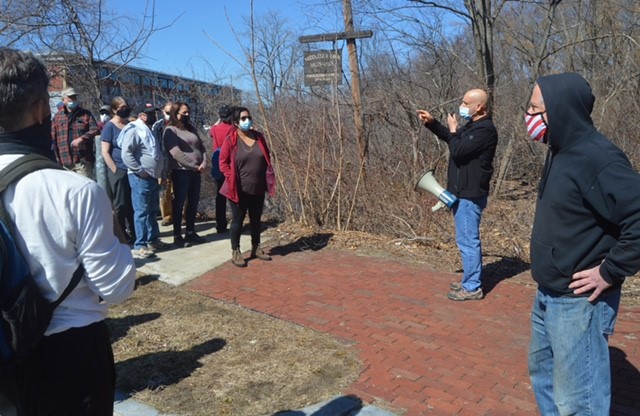
The second part of the walk started at the Baldwin Mansion (now Sichuan Garden II) after everyone had gotten back to their cars and driven over from the other side of the highway. About 30 people stayed on for this segment that went North to School Street. Former Woburn Alderman John Beauchamp joined the walk. Again, both towpath and the adjacent railroad bed were dry and passable, and the canal bed could be easily viewed. John Beauchamp is planning a May clean-up of this portion of canal.
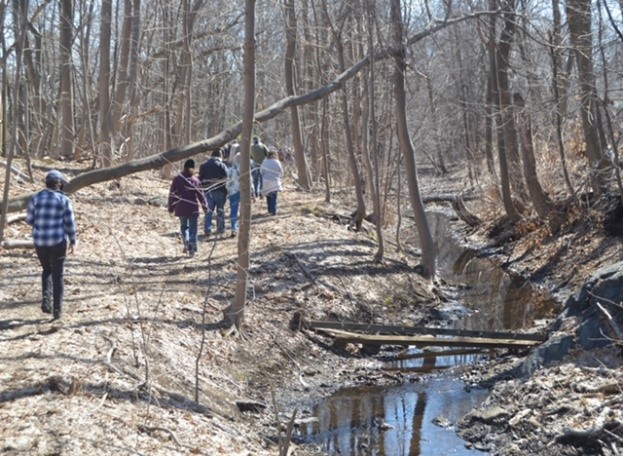
The Woburn Cinema Middlesex Canal Walk on first full day of Spring, March 21, 2021.
Pictures courtesy of Britton Boughner.
Editors’ Note: The Middlesex Canal Association extends a hearty thank you to James Cory and John Beauchamp of Woburn for clearing the debris from the trail prior to the spring walk, Jim Winkler and J Breen for leading the walk and Britton Boughner for photographing the event.
Sheldon brought oxen as revenge on an elegant hotel
by Larz F. Neilson
Built in 1835, the American House was Boston’s largest and most elegant hotel. A clerk there was shocked when he looked out the window. There in front of the hotel was a large herd of oxen.
Asa Sheldon (1788-1870) was probably the foremost contractor in the Boston area in the first half of the 19th century. He built railroads and many bridges. In 1835, he excavated Pemberton Hill in Boston.
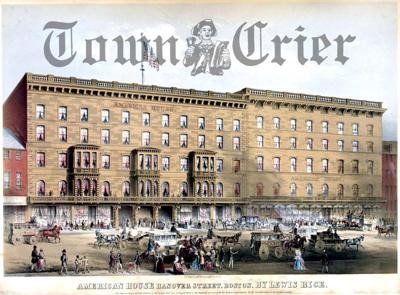
The American House, said to have been America’s most elegant hotel in the 1830s,
was ill-prepared for the oxen that Asa Sheldon brought as a registered guest. (Courtesy photo)
Boston originally had three prominent hills, that being the origin of the name of Tremont Street. Beacon Hill is still well-known, but there was also Pemberton Hill and Mt. Vernon. There were also two lesser hills, Copps Hill and Fort Hill.
Various property owners on the hillsides would cut into the hills to create level sites. This work, however, left unstable overhangs. Excavating an overhang only made it worse. The situation had but one remedy. The hills were all cut down in the early 1800s.
Sheldon had previously contracted for construction on the Boston & Lowell Railroad. He built a section in Wilmington that engineers said was noticeably better that other sections. He also built some of the bridges along the railroad.
The railroad president, Patrick Jackson, purchased the estate of Gardiner Greene, with about four acres on Pemberton Hill in Boston, between the State House and Scollay Square. Jackson hired Sheldon to excavate the hill.
Having determined that oxen were more economical than horses, Sheldon bought 30 span, then proceeded to hire many more teamsters with ox carts to haul the gravel. It was dumped into low land on the northerly side of Causeway Street, allowing the tracks of the Boston & Lowell to be extended. He also built two barns and a blacksmith shop for the oxen.
At one point, Sheldon went to the hotel in his work clothes. He had missed the last train home and needed a room. He had money, but he was refused, because of his clothes. The hotel had a dress code.
Sheldon knew that an innkeeper was obliged to take care of the horse or cattle of any guests. Shortly thereafter, he returned to the hotel wearing a suit that Jackson had purchased for him.
The clerk, failing to recognize Sheldon in his fine clothes, allowed him to register. Sheldon paid for his room. He then asked if he was indeed a registered guest. The clerk confirmed that he was.
Good, then would you please care for my animals, he said.
Sheldon had his revenge. The hotel, said to be the finest in the nation, was hardly able to care for the animals. He later had the oxen returned to the barns.
In his autobiography, Wilmington Farmer, Sheldon told how he would go among the spectators in his work clothes. At one point, there was a large crowd watching.
One man commented, “This is a tremendous piece of work.”
“It looks to me to be so,” Sheldon replied.
“I understand that the man who has taken this job has agreed to do it in six months. Do you know if this is so?” said the spectator.
“I understand he has,” said Sheldon, not letting on that he was the subject.
“Then he is a fool, let him be who he will,” said the man. “He can’t complete it in three years, if he employs all the men and teams he can work on it.”
Sheldon finished the job in five months. He then moved the blacksmith shop to Woburn Street in Wilmington.
Editors’ Note: This article was reprinted with permission of the author, Larz F. Neilson. The item first appeared in the February 6, 2021 issue of the Wilmington Town Crier. Although the article is not canal related, the editors felt the article would be of interest of our readers.
Loammi Baldwin in The New York Times
by Alec Ingraham
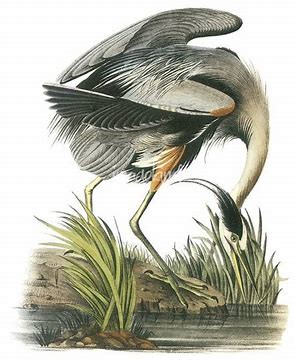 Audubon’s Great Blue Heron |
When you have a subscription to The New York Times, you, have access to their archives that date back to 1851. I wondered what I would find, if I searched for Loammi Baldwin, which I did, and found four articles. The first three articles below include only the information in the article about Baldwin. The fourth article is presented in its entirety.
AUCTIONS - Sept. 11, 1987
This Audubon set, known as the ‘’Double Elephant Folio,’’ because of the large size of the plates - each measure 37 1/2 by 25 1/2 inches - has never been offered for sale before. Owned first by an original subscriber, a civil engineer from Massachusetts named Loammi Baldwin (probably, Jr.), the book descended in his family to the Rev. Dr. Roswell Park, the husband of Baldwin’s great-granddaughter, who deposited it with the Buffalo Society of Natural Sciences in 1911, to which it was donated in 1914. The Buffalo society consigned the book to Christie’s.
NUMISMATICS (Early Paper Currency) - June 12, 1977
One artist at such fakery [counterfeiting] was Henry Dawkins who was apprehended and did time. His work was so good that when he got out of jail he was forthwith hired by the Colonials—the engraving on the border of the Massachusetts bill we see here was done by him.
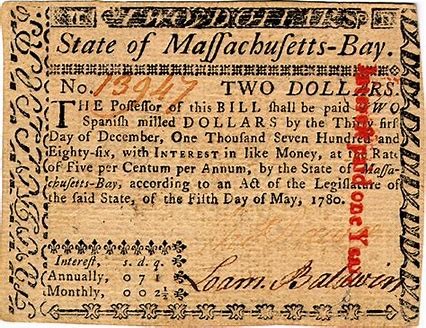
Two Dollar Bill signed by Loammi Baldwin
This $2 bill is signed by Loammi Baldwin and Richard Cranch. It was also printed in Philadelphia by Hall and Sellers. It is signed on the back by Peter Boyer under an inscription which says, in part: “The United States will ensure the payment … and will draw Bills of Exchange for the interest annually.
It evidently has been redeemed and canceled by holing. Usually when such bills were paid off, they were burned in the presence of a committee and a certificate of burning was issued for the Treasurer’s records.
The back of this piece, not shown, has a design in red and black and some further engraving work done by the reformed miscreant, Henry Dawkins.
Adams Saw Celebrations Marking Memorable Epoch in America on July 2 –
by Israel Shenker - July 2, 1976
Congress struggled to deal with details of military preparedness, decided to raise “one battalion of Germans,” and even resolved “that the pay of such soldiers at New York as have been enlisted at five dollars per month be raised to six dollars and two thirds per month.”
“The army continues healthy,” Colonel Loammi Baldwin, on duty at North River, New York, wrote his wife in Massachusetts. “The whores (by information) continue their imploy which is become very lucrative. ….”
On June 29, watchers on Staten Island sighted the fleet which had evacuated British troops from Boston over a hundred square-riggers. Couriers rode off to Connecticut and New Jersey to urge the militia there to hurry to the defense. On July 1 the British fleet moved to within a half-mile of the Long Island shore.
THE NORFOLK NAVY-YARD1 – July 20, 1862
A scientific gentleman who has recently visited Norfolk. Gives the Boston Traveller the following account of affairs there:
The Navy-yard was entirely destroyed, with the exception of the officers’ quarters. Why they were spared no one can tell. The attempt to blow up the dry dock, on the part of the rebels, was a failure; they burned the gates, and blasted a little of the stone near the gate-hinges. No doubt they swore rare secession oaths, and round ones, at the sturdy Quincy granite, and Loammi Baldwin, whose name in bright gilt letters still shines on the walls of this splendid piece of engineering.
A small model, some six feet high, of Bunker Hill Monument, located conspicuously near the entrance, strange to say was left uninjured, save that the silver shield, bearing the inscription, was torn off. The yard presented a sad picture of desolation. Thirty immense houses, filled with costly machinery and stores, furnished by the United States, were all destroyed, and a small marine guard, and a hundred Union employees engaged in gathering together the wreck of iron were the only occupants. This yard the finest naval depot in the country, will never be rebuilt till Virginia is a free state. In the meantime, Portsmouth, Gosport, and even Norfolk must look where best they may, for the generous annual stipend, afforded by the Navy Department, which have recklessly thrown away.
The rebel fortifications around Norfolk and upon the Elizabeth River were numerous, and, for the most part, well-constructed. The engineers, whoever they may have been, seem to have run mad upon the subject of military fortifications. A coast survey party, sent there by the Department to survey these works previous to their destruction, found thirteen batteries at different points on the Elizabeth River, varying from eleven to one gun in size, two exclusive fortifications, (Sewall’s Point and Craney Island,) and five entrenched camps. To fully man all these it would have required at least one hundred thousand men. The greatest force they ever had at Norfolk, according to the Secessionists themselves, was twenty-two thousand, and this, our informant thinks, is an overestimate. Most of the guns found in these earthworks were long ship’s 32’s, smooth bore. Some few rifled pieces were found, rifled at the Tredegar Works at Richmond, and marked C.S.A. They were good specimens of ordnance, and well preserved. With the exception of the latter, all the guns came from the Norfolk Navy yard. Indeed, this yard has supplied the rebels with most of their ordnance. Some of them having been carried as far as Fort Donelson and New Orleans. Nearly two thousand guns were given them by our abandonment of the Navy-yard.
Contrabands2 were daily coming in, who were fed and housed by the military authorities. Beyond this nothing was done, nor could be, with them or for them, for the disposition of them was then, and is still, an unsettled, vexing and perplexing question. Our military men want some definite orders respecting them—no matter what, only something authoritative and decisive. Till then they must grope about in the fog, as they have done to the present time.
1 During April 20-21, 1861, Union forces abandoned and burned the Gosport Navy Yard, as well as 11 ships, including the steam frigate USS Merrimack. The Merrimack was rebuilt as an iron clad, and renamed the CSS Virginia that did battle with the USS Monitor on March 9, 1862. On May 10, 1862 Confederate forces burned and abandoned the Gosport yard, and after Union forces re-occupied it, the shipyard was renamed, U.S. Navy Yard, Norfolk.
2 Slaves that escaped from bondage into Union lines were called Contrabands. Under the Fugitive Slave Law of 1850, all escaped slaves had to be returned to their owners. The Union army would not accede to this, so slaves were free from bondage, but still property.
The passage of Confiscation Act on July 17, 1862 called for the emancipation of slaves that came under Union control. It wasn’t until January 1, 1863 with the issue of Emancipation Proclamation that all persons in bondage in the seceding states were free. With the passage of the 13th Amendment to the Constitution on December 6, 1865, slavery was abolished.
Finis
Nominees for MCA Officers and Board: 2021-2022
Officers of the Middlesex Canal Association
J. Jeremiah Breen, President
Traci B. Jansen, Vice-President
Russell B. Silva, Treasurer
Neil P. Devins, Membership Secretary
Howard B. Winkler - Corresponding Secretary
Directors of the Middlesex Canal Association
Betty M. Bigwood, Chair of the Building Committee
Thomas H. Dahill, Jr., Artist in Residence
Roger K. Hagopian - Videographer
Debra Diffin Fox (TT copy co-editor)
Alec Ingraham (TT copy co-editor)
Robert Winters (webmaster, TT publisher)
Honorary Directors of the Middlesex Canal Association
Leonard H. Harmon
Howard B. Winkler - Treasurer Emeritus
William E. (Bill) Gerber
MEMBERSHIP
Proprietor (voting) $25 per year
Member (non-voting) $15 per year
Additional contributions are always welcome and gratefully accepted.
Please make check out to the: Middlesex Canal Association
and mail it to:
Neil P. Devins, Membership Secretary
28 Burlington Ave., Wilmington MA 01887
MISCELLANY
Back Issues - More than 50 years of back issues of Towpath Topics, together with an index to the content of all issues, are also available from our website http://middlesexcanal.org/towpath. These are an excellent resource for anyone who wishes to learn more about the canal and should be particularly useful for historic researchers.
Estate Planning - To those of you who are making your final arrangements, please remember the Middlesex Canal Association. Your help is vital to our future. Thank you for considering us.
Membership and Dues – There are two categories of membership: Proprietor (voting) and Member (non-voting). Annual dues for “Proprietor” are $25 and for “Member” just $15. Additional contributions are always welcome and gratefully accepted. If interested in becoming a “Proprietor” or a “Member” of the MCA, please mail membership checks to Neil Devins, 28 Burlington Avenue, Wilmington, MA 01887.
Museum & Reardon Room Rental - The facility is available at very reasonable rates for private affairs, and for non-profit organizations to hold meetings. The conference room holds up to 60 people and includes access to a kitchen and restrooms. For details and additional information please contact the museum at 978-670-2740.
Museum Shop - Looking for that perfect gift for a Middlesex Canal aficionado? Don’t forget to check out the inventory of canal related books, maps, and other items of general interest available at the museum shop. The store is open weekends from noon to 4:00pm except during holidays.
Nameplate - Excerpt from an acrylic reproduction of a watercolor painted by Jabez Ward Barton, ca. 1825, entitled “View from William Rogers House”. Shown, looking west, may be the packet boat George Washington being towed across the Concord River from the Floating Towpath at North Billerica.
Web Site – The URL for the Middlesex Canal Association’s web site is www.middlesexcanal.org. Our webmaster, Robert Winters, keeps the site up to date. Events, articles and other information will sometimes appear there before it can get to you through Towpath Topics. Please check the site from time to time for new entries.
The first issue of the Middlesex Canal Association newsletter was published in October, 1963.
Originally named “Canal News”, the first issue featured a contest to name the newsletter. A year later, the newsletter was renamed “Towpath Topics.”
Towpath Topics is edited and published by Debra Fox, Alec Ingraham, and Robert Winters.
Corrections, contributions and ideas for future issues are always welcome.
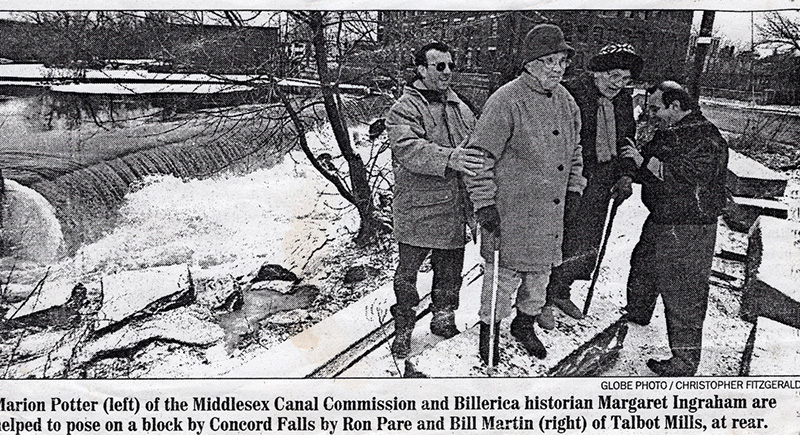
A Picture from the Past
This picture appeared in the February 9, 1997 issue of the Boston Globe. The photograph was shot on a cold, drizzly winter’s day. Not long after it appeared in the newspaper, John and Shayne Reardon began discussions with Ron Pare, who, at the time, was in the process of restoring the Faulkner Mill. Their intent was to establish the Middlesex Canal Association Museum and Visitors’ Center on the first floor of the mill’s main building. In the background, the warehouse at 2 Old Elm Street is visible. With continued community support, 2 Old Elm will be the new site of the MCA Museum.
Please consider making a memorial donation to the cause in the name of Marion Potter and/or Margaret Ingraham. Your support is greatly appreciated.
Mail to: MCA, P. O. Box 333, Billerica, MA 01821. Thank you.
